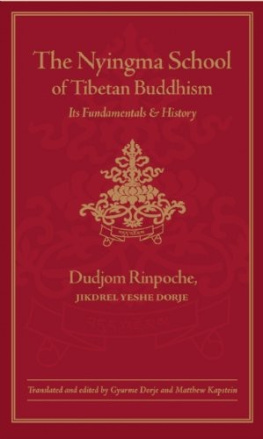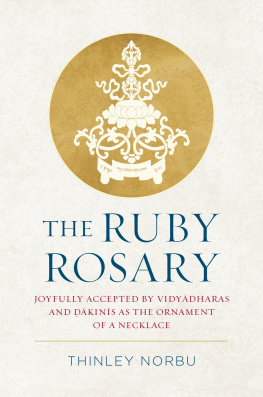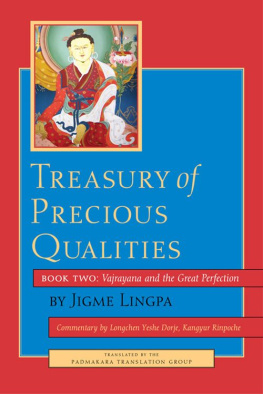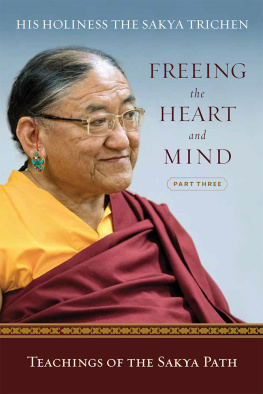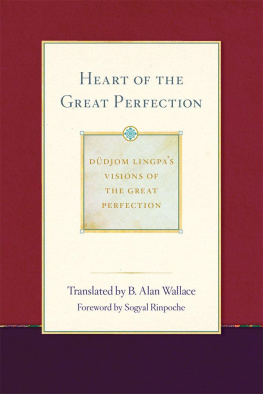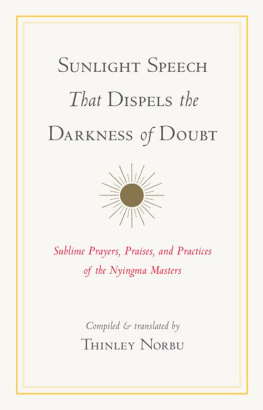T HIS FIRST English translation of The Nyingma School of Tibetan Buddhism is one of the master works of recent Buddhist scholarship. Written by the great Nyingma master, His Holiness Dudjom Rinpoche, the book covers in detail and depth both the fundamental teachings and the history of Tibetan Buddhisms oldest school. In the section on the teachings, His Holiness Dudjom Rinpoche delineates the entire range of the Buddhist spiritual and philosophical systems. These form a dynamic gradation of experience, from the mundane level of cyclic existence (samsara) to that of the Great Perfection (dzogchen). In the section on the history of the Nyingma School, the reader is given a fascinating account of the religious development of Tibet from the seventh century until the present day. Included are numerous biographies of the major teachers of the lineage. Extensive notes and records of source materials round out a volume that constitutes the most complete work of its kind available in the West.
The Nyingma School of Tibetan Buddhism Its Fundamentals and History

HIS HOLINESS DUDJOM RINPOCHE
First Edition 1991
Wisdom Publications
199 Elm Street
Somerville MA 02144 USA
wisdompubs.org
1991 Dudjom Rinpoche, Gyurme Dorje, and Matthew Kapstein
Line drawings 1991 Chris Conlon
Maps 1991 Gyurme Dorje and Michael Farmer
All rights reserved.
No part of this book may be reproduced in any form or by any means, electronic or mechanical, including photography, recording, or by any information storage and retrieval system or technologies now known or later developed, without the permission in writing from the publisher.
Library of Congress Cataloging-in-Publication Data
Available upon request.
ISBN: 0-86171-199-4
6 5 4 3
Cover by Gopa & Ted2
Interior by Character Graphics
Wisdom Publications books are printed on acid-free paper and meet the guidelines for permanence and durability of the Committee on Production Guidelines for Book Longevity of the Council on Library Resources.
The Nyingma School of Tibetan Buddhism Its Fundamentals and History
Section One: The Translations
Dudjom Rinpoche, Jikdrel Yeshe Dorje
Translated and edited by
Gyurme Dorje and Matthew Kapstein

WISDOM PUBLICATIONS Boston
This book is dedicated to the continued enlightened activity of HIS HOLINESS DUDJOM RIPOCHE and to all those who maintain the living traditions of Tibetan Buddhism.
General Contents
PLATES
.
.
.
.
.
.
.
.
.
.
.
.
.
.
.
.
.
.
.
LINE DRAWINGS

Trhadruk, possibly Tibets first Buddhist temple

Samye, general view from Hepori

Lhodrak Khoting, a Border Taming temple

Lhodrak Kharcu, sacred site of Padmasambhava and Namkei Nyingpo

Karcung Temple of the Indesctructible Expanse, near Lhasa

ncangdo Peme Trashi Gepel Temple,
with Longcenpas retreat centre on the hillside behind
His Holiness Dudjom Rinpoche, Jikdrel Yeshe Dorje, (1904-87) was appointed by His Holiness Dalai Lama XIV as the supreme head of the Nyingma tradition of Tibetan Buddhism. He was an enlightened yogin and meditation master, a discoverer of concealed treasure teachings ( gter-ston ) who was inseparable from Guru Rinpoche [Padmasambhava], the most prolific of contemporary Tibetan scholars, and an incarnate lama who had intentionally emanated for the sake of sentient beings through seventeen successive lives. In ancient India these emanations included: Buddha kyamunis foremost disciple riputra; the mahsiddha Saraha; Kadhara, the religious minister of King Indrabhti; and the i Hkara. In Tibet, they included: Khyeucung Lotswa, one of Padmasambhavas twenty-five disciples; Smtijnanakrti whose lifetime demarcated the transition from the ancient to the new system of translation; Rongzom Paita who was among the first to compose major treatises within the Nyingma tradition; Katok Tampa Deshek (1122-92) who founded the monastery of Katok in East Tibet; Chgyel Phakpa (1235-80) who established a Sakya administration in Central Tibet; Rikdzin Ddl Dorje (1615-72) who is famous for his discovery of concealed treasure teachings ( gter-ma ) in the Puwo region of south-east Tibet; Gyelse Sonam Detsen, responsible for revitalising Katok; and the treasure-finder Djom Lingpa (1835-1904) who discovered the New Treasures ( gter-gsar).
Like many of his predecessors, His Holiness was also renowned as a great discoverer of concealed treasure teachings which are now widely practised and propagated. These are primarily the direct treasures of intention or mind treasures ( dgongs-gter ) of the awareness-holders ( vidydhara ) concerning the inner tantras of the secret mantra vehicle, which can bring about the unsurpassed enlightenment of the rainbow body in one lifetime.
He took birth in the Pemak region on the frontier of Tibet, on the twenty-third day of the fourth Tibetan month, 1904. This birth occured while his predecessor Djom Lingpa was still alive. Djom Lingpa himself gave the specific instructions of how to find his authentic emanation. His father was Tlku Jampel Norbu, who was Prince of Kanam, a direct descendant of King Trhisong Detsen, and his mother, Namgyel Drlma.
In his youth His Holiness received the transmissions and direct blessings of Guru Rinpoche, Yeshe Tshogyel and Majur in person. He received all the lineages of the Nyingma school from his lamas: Phngong Tlku Gyurme Ngedn Wangpo, Jedrung Trhinle Campa Jungne, Gyurme Phendei zer, Namdrl Gyamtso of Mindrling, Gendn Gyamtso and Khenpo Aten, amongst others. He mastered every tradition of Tibetan Buddhism. Astonishingly, at the age of fourteen, he gave the full empowerment and oral transmission of the Store of Precious Treasure (rin-chen gter-mdzod), which are the collected treasure texts of the Nyingma lineage. From that time on, he gave major empowerments relating to different treasure cycles, and at the same time composed many means for attainment ( sdhana ) which elucidated the profound teachings of the buddhadharma. He wrote commentaries both on his predecessors teachings and on his own revealed treasures. When he was seventeen years old he composed his first celebrated treatise on the Great Perfection ( rdzogs-pa chen-po). He became widely renowned as a scholar and meditation master, and was followed by many students. Among his students in Tibet and throughout the Himalayan regions, many have shown the signs of full enlightenment.

